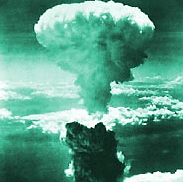After 20 Years of US Aid, Russia Goes Solo on Controlling Loose Nukes

(Voice of America – James Brooke – James Brooke is VOA Moscow bureau chief, covering Russia and the former USSR – October 18, 2012)
The day that Russia’s government decided last week to end its participation in the Nunn-Lugar Cooperative Threat Reduction program, a huge, mushroom-shaped cloud rose high in the air over Orenburg.
In this case, the dust was kicked up by massive, accidental blasts of conventional weapons, largely stores of Soviet-era artillery shells.
To avoid the real thing, a nuclear explosion, American taxpayers have paid $7 billion over the last 20 years to cut the threat of loose nukes scattered around the former Soviet Union. The program did things as simple as build secure fences around warehouses that held nuclear materials, and as complicated as evacuating all nuclear weapons from Belarus, Kazakhstan and Ukraine.
The thinking was that, given the lax safety measures of the Soviet Union, and the “anything goes” capitalism that followed the Soviet collapse, Russia and other successor states needed help fast.
But 20 years later, Russia’s government finances are among the best in the world. The Kremlin bridles at what it sees as the paternalism and intrusion of foreign aid in securing nuclear, chemical and biological materials.
But that mushroom-shaped cloud over Orenburg hangs like a question mark over one all-Russian arms disposal program.
Down on the ground, at the Donguz military range on the morning of Oct. 9, Private Alexander Kasatkin had been unloading old ammunition for controlled disposal. The work was tiring and boring, so Private Kasatkin decided to sneak a cigarette break.
Apparently, an officer approached.
The private tried to ground out the butt with his army boot.
Oops.
The ensuing fire raged for four hours, blowing up 4,000 tons of ammunition.
Private Kasatkin, being a young draftee, was fleet of foot and managed to scamper out of harm’s way, along with 300 other soldiers.
Amazingly, the only injury was to an officer discovered later in a protective bunker.
He was found to be suffering, understandably, from shell shock.
As sappers comb the area finding 724 unexploded shells at last count it would be nice to write off the Orenburg blast off as an embarrassing coincidence to the Kremlin’s decision to go it alone on nuclear and chemical disposal.
But reporters with computer search services quickly recalled that an officer was killed last month by an ammunition disposal blast, and that six soldiers were killed last May in a similar accident.
Alexander Kanshin, a member of the Russia’s Public Chamber, pulled it all together, saying at a press conference: “More than 50 servicemen have died and over 300 have been wounded in the scrapping of munitions in recent years.”
The military state that was the Soviet Union left behind vast stores of armaments. Those old explosives are becoming unstable. Rubber seals are drying and cracking.
During 20 years of disposing nuclear materials and weapons under the Nunn-Lugar program, there are no known fatalities.
Instead, the track record is pretty impressive.
The day after the Russian Foreign Ministry announced that Russia wants to end not amend Nunn-Lugar, Senator Richard Lugar, Republican from Indiana, and one of the programs initial sponsors, announced the results of 20 years:
“The Nunn-Lugar scorecard now totals 7,610 strategic nuclear warheads deactivated, 902 intercontinental ballistic missiles (ICBMs) destroyed, 498 ICBM silos eliminated, 191 ICBM mobile launchers destroyed, 155 bombers eliminated, 906 nuclear air-to-surface missiles (ASMs) destroyed, 492 SLBM launchers eliminated, 684 submarine launched ballistic missiles (SLBMs) eliminated, 33 nuclear submarines capable of launching ballistic missiles destroyed, 194 nuclear test tunnels eliminated, 3,192.3 metric tons of Russian and Albanian chemical weapons agent destroyed, 590 nuclear weapons transport train shipments secured, security at 24 nuclear weapons storage sites upgraded, 39 biological threat monitoring stations built and equipped.”
This work has gone on largely behind the scenes. You have not heard about it because it was done safely, and professionally, without big oops moments.
This week brought a typical small item on the Interfax news wire.
On Oct. 18, work was completed in Kazakhstan on a 20-year American-Kazakhstan-Russian project to clean up Semipalatinsk, once the world’s largest nuclear testing ground. Stretching over 18,500 square kilometers, Semipalatinsk was used for testing about 500 nuclear bombs over 40 years, from 1949 to 1989.
Also this week, Kazakhstan agreed to host in Almaty the headquarters of the International Science and Technology Center (ISTC). Set up in Moscow in 1992, the largely Western and Japanese-funded program has helped 58,000 former Soviet weapons scientists find peaceful work in industry and in universities. Last year, Russia pulled out of the agreement, prompting the group to decide to move from Moscow.
As dust settled over Orenburg last week, Vedemosti, an independent Moscow newspaper, questioned whether: “Declarations of self-sufficiency to dispose of ammunition sound good in light of the explosion of thousands of shells in the Orenburg region.”
[image is adapted from a U.S. Navy file photo of an atomic test]
